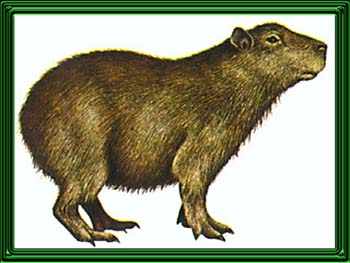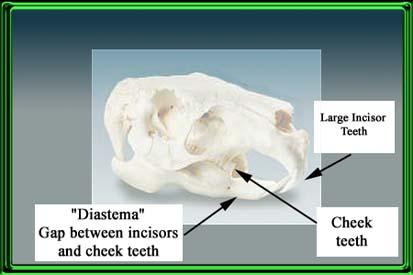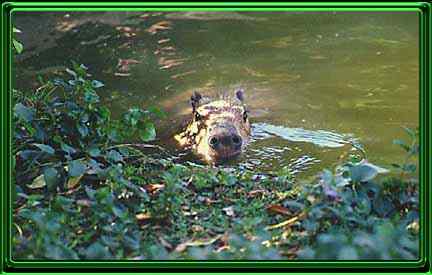
(The Capybara)
Class: Mammalia.
Order: Rodentia.
Family: Hydrochoeridae.
Genus species: Hydrochaeris hydrochaeris.
The capybara is the largest rodent in the world. Rodents are distinguished by their sharp-edged, 2 incisors. Capybara incisors are yellow (a look at the picture below will show the teeth and how they are set up, when the incisors are in action the cheek teeth aren't and vice versa, this is allowed because of the diastema). Its outer appearance looks like a giant guinea pig. It comes in colours from brown to red and all the colours in between. Its skin is tough and thinly haired. The capybara has short ears, a small nose, and short hair all over their bodies. Their hide is made into high quality leather. Their scientific name, Hydrochoerus, means "water pig".
In the wild, the capybara likes to shelter and hide in thick brush. In totally wild habitat, it is active in the day and at night, resting in it's burrow during the day, but where it is bothered by people, it has become nocturnal or crepuscular. The capybara is hunted by farmers for meat and hides and to protect agricultural crops. Its teeth are prized as ornaments by natives and the body fat is used in pharmaceuticals. In some areas it is becoming rare, while in other areas it thrives. Some ranchers with marginal land for cattle because of excessive wetlands, have begun to farm capybara as livestock.
It is native to the Amazon Rainforest. Panama and parts of the Andes Mountains, Columbia, Uruguay, and Argentina, and is always to be found near water. No doubt someone will import one or two and then they will escape into the wild.
The capybara lives in large groups up to 20 (though a lot bigger groups of up to 100 have been seen especially in the dry season when they congregate around water holes) with one head male and 1 to several females and other males. They communicate with barks, whistles, clicks, squeals, and grunts plus smell. Observation has shown that they mostly sit around all day. The name 'capybara' means 'master of the grasses' in the language of the Guarani Indians and water pig in some unknown language.
Capybaras are slightly clumsy on land, but are excellent swimmers and divers, but they are mammals, and can't stay under water forever, however they can stay under water for a few minutes, and can even sleep underwater if necessary with only their nose sticking out of the water.
Biology:
Size:
The weight of a male is 77 to 140 pounds, and the female is 80 to 145 pounds. The capybara's large but squat body has a length from 42 to 53 inches, and a height at shoulder from 20 to 24 inches. Its eyes are small and located at the top of their head with their ears and nose (very similar to the Coypu). It also has a large bump located here which may be a scent gland. Their legs are short but their front legs are longer than the back legs and their toes are slightly webbed with 4 toes on the front foot and 3 toes on the back.Colour:
It comes in colours from brown to red and all the colours in between. Its skin is tough and thinly haired.Breeding Season:
Mating is year round, however mostly occurs in April and May and again in the autumn. Capybaras mate in the water just before rainy season.Litters/Year:
Most females have one litter per year, although two litters are not uncommon.Numbers per Litter:
Females have 5 pair of mammae (nipples) and have litters of 2-8, averaging 5 babies. Gestation is 120-150 days. With babies weighing 3 lb. The young can follow the mother from birth and eat plants right away, but they still drink milk and are weaned at 16 weeks. The entire group of females help take care of her babies which reach sexual maturity at 15 months.Lifespan:
The capybara's life span in the wild is about 8-10 years, but when in the zoo their life span is about 12 years.Food preferences:
Water plants, grass, vegetables and tree bark.Predators:
Capybaras protect themselves in a different way than other animals do. If they hear danger coming, they will dive into the water and hide like 'cowards'. Their natural enemies include the anaconda and the jacare. Its worst enemies are the jaguar, puma, caiman and of course MAN. Capybaras sometimes hide in floating vegetation.

